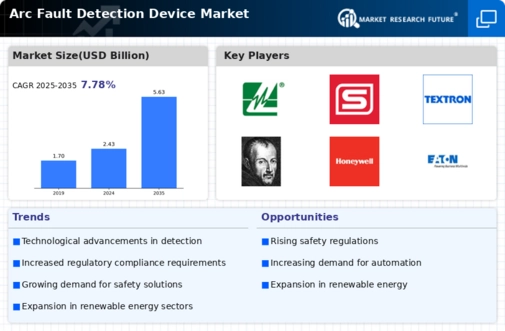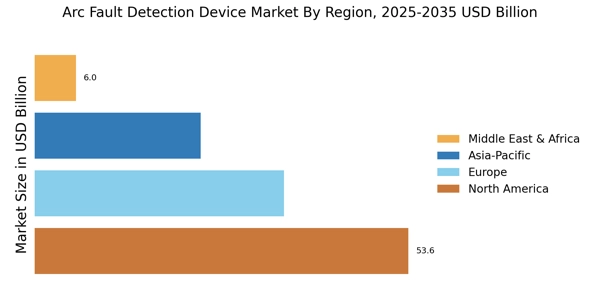Rising Incidence of Electrical Fires
The rising incidence of electrical fires serves as a compelling driver for the Arc Fault Detection Device Market. Statistics indicate that electrical faults are a leading cause of residential and commercial fires, prompting a greater focus on preventive measures. As awareness of these risks increases, consumers and businesses are more inclined to invest in arc fault detection devices to safeguard their properties. This trend is further supported by insurance companies, which may offer incentives for the installation of such devices, recognizing their potential to reduce claims related to electrical fires. The market data suggests that the demand for arc fault detection devices is likely to rise in response to these safety concerns, with projections indicating a potential market growth of 6% annually in the coming years.
Increasing Awareness of Electrical Safety
The rising awareness regarding electrical safety is a pivotal driver for the Arc Fault Detection Device Market. As consumers and businesses become more informed about the risks associated with electrical faults, the demand for devices that can detect and mitigate these hazards is likely to increase. Educational campaigns and safety regulations have contributed to this heightened awareness, prompting both residential and commercial sectors to invest in arc fault detection technologies. This trend is reflected in the market data, which indicates a steady growth rate of approximately 8% annually in the adoption of these devices. Consequently, manufacturers are focusing on developing advanced solutions that not only comply with safety standards but also enhance user experience, thereby driving the Arc Fault Detection Device Market forward.
Growing Construction and Renovation Activities
The surge in construction and renovation activities is a vital driver for the Arc Fault Detection Device Market. As new buildings are constructed and existing structures are renovated, there is an increasing emphasis on incorporating advanced safety features, including arc fault detection devices. This trend is particularly pronounced in residential construction, where homeowners are prioritizing safety and compliance with modern electrical codes. Market data reveals that the construction sector is projected to grow at a CAGR of approximately 5% through 2026, which will likely bolster the demand for arc fault detection devices. Furthermore, as more builders and contractors recognize the importance of electrical safety, the integration of these devices into new projects is becoming standard practice, thereby enhancing the overall market landscape.
Regulatory Mandates and Compliance Requirements
Regulatory mandates and compliance requirements are significant drivers of the Arc Fault Detection Device Market. Governments and regulatory bodies worldwide have established stringent safety standards aimed at reducing electrical hazards. These regulations often necessitate the installation of arc fault detection devices in residential and commercial buildings, thereby creating a robust demand for these products. For instance, the National Electrical Code (NEC) in various regions mandates the use of arc fault circuit interrupters (AFCIs) in specific applications. As a result, manufacturers are compelled to innovate and ensure their products meet these evolving standards. The market data indicates that compliance-driven demand is expected to contribute to a compound annual growth rate (CAGR) of around 7% in the Arc Fault Detection Device Market over the next few years.
Technological Advancements in Detection Devices
Technological advancements play a crucial role in shaping the Arc Fault Detection Device Market. Innovations in sensor technology, data analytics, and connectivity have led to the development of more sophisticated detection devices. These advancements enable devices to accurately identify arc faults and differentiate them from normal electrical activity, reducing the likelihood of false alarms. The integration of smart technologies, such as IoT capabilities, allows for real-time monitoring and alerts, further enhancing safety measures. Market data suggests that the segment of smart arc fault detection devices is expected to grow significantly, potentially reaching a market share of over 30% by 2027. This trend indicates a shift towards more intelligent solutions in the Arc Fault Detection Device Market, appealing to tech-savvy consumers and businesses alike.


















Leave a Comment